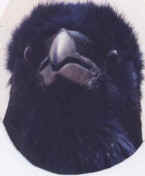
 CREATURED
CREATUREDCONNECTION
anecdotes
Spring 2001 Edition

 CREATURED
CREATURED
CONNECTION
anecdotes
Spring 2001 Edition
Over the last few years, Karen Hannon, co-founder and director of The Branford River Raptor Center, in Branford, CT, has taken in numerous Eastern screech owls (Otus asio) for rehabilitation. In 2000, for example, about a dozen were brought in for assistance. Many of these owls – sometimes the survivors of entire families – were brought to the center, orphaned or injured as a result of falling out of their tree cavity nests, when the tree was cut down.
Growing concerns about the need to conserve appropriate habitat for a diminishing Connecticut population of this raptor, or bird of prey, inspired a nesting site project. Recent evidence suggests that screech owl populations may have declined in the Northeast.
In Connecticut, a 10_year census revealed local population declines during certain times of year. When trees are cut from an area or when trees with natural cavities are removed and not replaced with nest boxes, screech owls disappear from the area.
The Raptor Center was awarded a grant from Northeast Utilities Environmental Community Grant Program, for the purpose of providing nesting sites for the Eastern screech owl. This grant will provide the opportunity for the evaluation, establishment, and maintenance of suitable nesting sites.
The Eastern screech owl, the smallest of the tufted owls with ear tufts in the eastern U.S., stands about 8-9 inches high and has a wingspan of 20 inches. Weighing about 6 oz., the birds have several color "morphs" – grey, red, and brown. Most Eastern screech owls are much browner than Western varieties, but all three morphs occur in most populations.
According to The Sibley Guide to Birds," by David Sibley (2000), "up to 60% are red in mid-eastern states (Ohio to Virginia)." He adds that the northern birds are usually "larger, paler, and fluffier" than southern counterparts. The term "Eastern screech owl" refers not just to the east coast, but the entire eastern half of the U.S., in which these birds are fairly ubiquitous.
Named for its distinctive "song," this little owl actually has more than one. The primary song resembles a whinneying horse, with a cascade of descending notes with a husky falsetto tone. Common names for the owl refer to this: "whickering owl," "whinnerying owl."
Sometimes these owls make barking sounds, or calls that resemble chuckles. There is also a tremolo of long whistled trills on the same pitch, lasting up to three seconds. The female will call at slightly higher pitches.
Historically, some people have interpreted the whinney as "mournful" and the tremolos to be haunting. According to John Terres, in The Audubon Society Encyclopedia of North American Birds (1980), the call "has aroused great suspicion and fear among country people."
Fortunately, contemporary society has a more informed and benevolent view of this little "scritch owl." We know, for example, that they are helpful, consuming mice, shrews and a wide array of insects, such as cutworms, cicadas, caterpillars, grasshoppers, crickets, ants, beetles.
Described as a rather "quiet, gentle" bird, the owls make warnings by snapping their bills. They have accustomed themselves to areas of human habitations, and have been seen bathing at night in backyard birdbaths!
Hunting soon after dusk, the screech owl swoops over meadows and treetops. In flight, they snag June beetles from midair with their beaks, or snatch them from twigs with their talons. They respond readily at night to imitated calls or squeaking notes.
Since screech owls hunt in small territories and can tolerate the presence of people, they can be found in suburban and city woodlands. Installing nest boxes provided a means of supporting the screech owl population.
This Raptor Center project will involve surveying areas for screech owls, building nest boxes and installing the boxes in potential screech owl habitats. The nest boxes will be maintained and monitored throughout the nesting season. Data collection will provide an account of the screech owl population and ascertain its trend in the areas.
Increasing public awareness about the important environmental issues is vital in conservation efforts to preserve birds of prey. One of the Branford River Center's main goals is to educate people about birds of prey and their importance in our environment.
For more information, e_mail
[email protected].This article was originally published (March 22, 2001) in The Source, The Sound, The Harbor News, and the Guilford Courier, several CT shoreline newspapers. Reprinted by permission of Shorepublishing, Inc., Madison, CT
Return to Anecdotes Spring 2001 Edition
Getting a taste of God's creation as it should be!
The educational purpose of Creatured Connection is to help make this world more compassionate and environmentally friendly and to bring to the public awareness such subjects and issues as: alien, animal, animals, art, article, articles, author, avian, beautiful, beauty, bias, bioethics, biopolitics, bird, birds, book, books, butterflies, butterfly, Canada, consciousness, compassion, creature, creatures, conservation, cygnet, dragonfly, earth, earth day, educate, education, educational, empathy, ethics, environment, environmental, environmentalism, flight, flowers, gaia, gaiaquest, grail, Holloway, human, humane, intelligence, interconnectedness, interrelatedness, intolerance, invasive, lectures, journal, journalism, journalist, monarch, nonnative, native, nativism, nonviolence, natural, opinion, osprey, peace, peacemaking, picture, pictures, poem, poems, poetry, photo, photographs, photography, prejudice, rehabilitation, rehabilitator, relatedness, respect, rights, swan, swans, mute swans, swan song, snow, goose, geese, snow goose, species, sparrow, stereotyping, story, stories, Sue Holloway, teach, teaching, tolerance, trees, tree, Vermont, violence, waterfowl, welfare, wildlife, and wonder.
This site is hosted and maintained by:
The Mary T. and Frank L. Hoffman Family Foundation
Thank you for visiting all-creatures.org.
Since ![]()